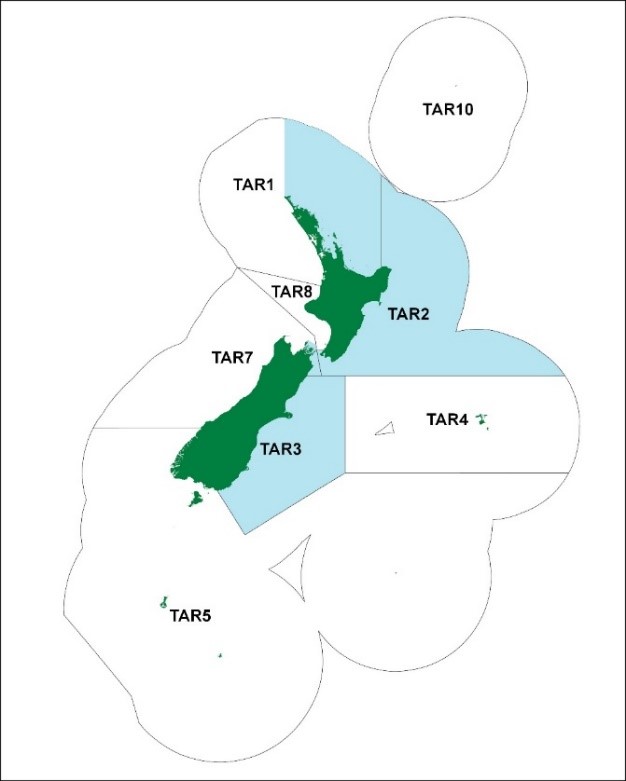Where we are planning to rebuild tarakihi numbers
The rebuild plan covers the entire east coast of New Zealand. The areas it includes are:
- TAR2 and TAR3
- the east coast parts of TAR1 and TAR7.
Tarakihi off the east coast are considered to be a single breeding population. This is why the rebuild plan covers these 4 management areas.

Overview of the east coast tarakihi fisheries
More than 90% of tarakihi caught is sold in New Zealand. Tarakihi is also highly valued by recreational fishers, and considered taonga by Māori. Because the tarakihi is so popular and widely fished, the number of fish has declined. In 2019, tarakihi numbers were at less than half of target levels.
To allow numbers to recover, we've lowered the total amount of tarakihi that can be caught commercially each year. Under these new catch limits, we estimate it will take 25 years to get numbers back to the target.
Speeding up the recovery
To help speed up the recovery further, the Minister of Fisheries agreed to an industry-developed rebuild plan. The plan commits to several voluntary measures and a 20-year rebuild timeframe.
It was developed by:
Read the rebuild plan
Eastern tarakihi management strategy and rebuild plan 2019 [PDF, 11 MB]
The plan represents a commitment to sustainably managing and fishing east coast tarakihi. It focuses on:
- improving fishing methods
- research to better understand the fishery
- avoiding catching younger tarakihi (our research suggests that doing this could help increase how quickly numbers rebuild).
The plan involves getting more information on the fishery. This will include:
- verifying the commercial fishing data
- taking samples of tarakihi catches
- reviewing management strategies.
The information we get will help us make more informed decisions on future changes to the fishery.
Using on-board cameras
As well as the rebuild plan, the Minister of Fisheries sought in-principal agreement from the industry to use on-board cameras in TAR2 and TAR3. It is proposed that the cameras will cover most of the commercial fishing in these areas. Cameras will give us more confidence and assurance that industry are following the plan.
Read more about on-board cameras for commercial fishing vessels
Tracking progress of the rebuild
We'll post quarterly progress reports on this page as they become available.
2023/24 fishing year
1 April – 30 June 2024 [PDF, 769 KB]
1 January – 31 March 2024 [PDF, 2 MB]
1 October – 31 December 2023 [PDF, 1.4 MB]
2022/23 fishing year
1 July – 30 September 2023 [PDF, 1.5 MB]
1 April – 30 June 2023 [PDF, 1.9 MB]
1 January – 31 March 2023 [PDF, 1.3 MB]
1 October – 31 December 2022 [PDF, 1.2 MB]
2021/22 fishing year
1 July – 30 September 2022 [PDF, 684 KB]
1 April – 30 June 2022 [PDF, 1.2 MB]
1 January – 31 March 2022 [PDF, 1.2 MB]
1 October – 31 December 2021 [PDF, 1.2 MB]
2020/21 fishing year
1 July – 30 September 2021 [PDF, 671 KB]
1 April – 30 June 2021 [PDF, 664 KB]
1 January – 31 March 2021 [PDF, 665 KB]
1 October – 31 December 2020 [PDF, 666 KB]
2019/20 fishing year
1 July – 30 September 2020 [PDF, 731 KB]
1 April – 30 June 2020 [PDF, 660 KB]
1 January – 31 March 2020 [PDF, 554 KB]
1 October 2019 – 31 December 2019 [PDF, 1.1 MB]
Find out more
Review of sustainability measures for 1 October 2018
Review of sustainability measures for 1 October 2019
Fisheries Assessment Plenary, May 2019 [PDF, 20 MB] (see pages 1521–1557)
Harvest Strategy Standard for New Zealand Fisheries [PDF, 309 KB]
Who to contact
If you have questions about east coast tarakihi numbers, email info@mpi.govt.nz








